Presenters from some of the various STEAM Splash workshops discuss their activities in this in-depth look at STEAM Splash days.
Presenters from some of the various STEAM Splash workshops discuss their activities in this in-depth look at STEAM Splash days.
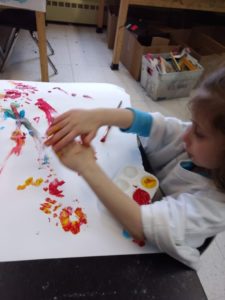 Young children love the immediate satisfaction of painting. Mixing colors is a magic and instant alchemy that has enthralled our Pre-K students for the past few weeks in art. Mr. Mirsky challenged the children to “invent” as many new colors as they could. With this prompting, children learned the basics of color theory and improved fine motor control, but they were also given the opportunity to create something the world has never seen before. That’s the sense of discovery we love to encourage in our art room!
Young children love the immediate satisfaction of painting. Mixing colors is a magic and instant alchemy that has enthralled our Pre-K students for the past few weeks in art. Mr. Mirsky challenged the children to “invent” as many new colors as they could. With this prompting, children learned the basics of color theory and improved fine motor control, but they were also given the opportunity to create something the world has never seen before. That’s the sense of discovery we love to encourage in our art room!
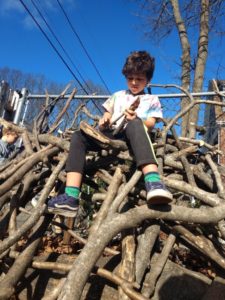 Recess and unstructured play are critically important for elementary school children. These non-academic learning experiences promote fine and gross motor development, social emotional growth, and interpersonal bonding. Recently, children have been constructing and deconstructing a stick fort in the parking lot — one of the designated areas where some students choose to have recess. Using ingenuity, creativity, collaboration and design thinking, kids forge temporary structures and lasting friendships. This imaginative play is only possible when you trust children to explore their world on their own terms, a hallmark of the philosophy of a progressive school like ours.
Recess and unstructured play are critically important for elementary school children. These non-academic learning experiences promote fine and gross motor development, social emotional growth, and interpersonal bonding. Recently, children have been constructing and deconstructing a stick fort in the parking lot — one of the designated areas where some students choose to have recess. Using ingenuity, creativity, collaboration and design thinking, kids forge temporary structures and lasting friendships. This imaginative play is only possible when you trust children to explore their world on their own terms, a hallmark of the philosophy of a progressive school like ours. 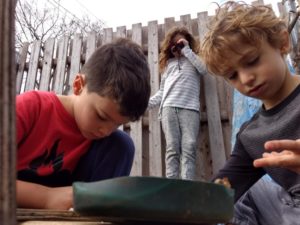
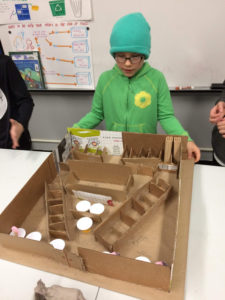 Grades 3-5 have been practicing collaboration in TikkunXDesign while designing and building their own schools. In small groups, students brainstormed important elements of a school, created a floor plan, and built up walls and furniture to create a demonstrative model. At each point along the way, students were asked to build upon each other’s ideas, come to agreements about how to proceed, and delegate tasks to each other.
Grades 3-5 have been practicing collaboration in TikkunXDesign while designing and building their own schools. In small groups, students brainstormed important elements of a school, created a floor plan, and built up walls and furniture to create a demonstrative model. At each point along the way, students were asked to build upon each other’s ideas, come to agreements about how to proceed, and delegate tasks to each other.
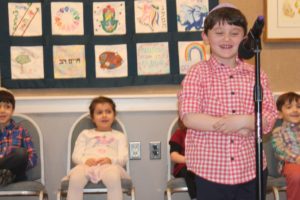 One of the biggest celebrations that takes place in kindergarten is the Naming Ceremony. This important milestone event highlights the beginning of our young students’ journey into literacy – in both English and Hebrew. Focusing on names gives our children an opportunity to begin exploring their Jewish identities through their naming story.
One of the biggest celebrations that takes place in kindergarten is the Naming Ceremony. This important milestone event highlights the beginning of our young students’ journey into literacy – in both English and Hebrew. Focusing on names gives our children an opportunity to begin exploring their Jewish identities through their naming story.
Certain mantras that infuse our curriculum come from the Design Thinking mindsets that we practice in TikkunXDesign. The mindset constraints drive creativity is especially prevalent in art. By imposing constraints, Joe Mirsky, art teacher extraordinaire, challenges his students to think outside the box. A great example of this principle is the attachment test. The idea is simple: encourage children to design creative ways to attach objects together without using glue or tape. Once students demonstrate mastery in an attachment test, glue and tape become available for use in art class.
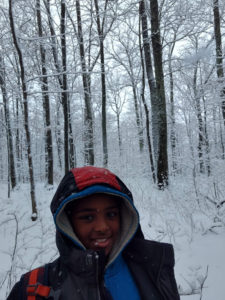 It has long been a JCDSRI tradition that our 5th grade class travels to Camp Isabella Freedman in CT to participate in a 4 day environmental retreat with a Jewish lens. This year’s trip was picked up by our local paper, Jewish Rhode Island. Read more about what our students got out of the trip and what lessons they brought home with them.
It has long been a JCDSRI tradition that our 5th grade class travels to Camp Isabella Freedman in CT to participate in a 4 day environmental retreat with a Jewish lens. This year’s trip was picked up by our local paper, Jewish Rhode Island. Read more about what our students got out of the trip and what lessons they brought home with them.
Teva program inspires JCDSRI students to help heal the earth
As a Jewish school, we teach our students the story of Hanukkah. As a progressive school, we encourage our students to interpret and relate to the story of the holiday in their own way. First graders represented themes of the holiday in Lego creations. (A class favorite!) Students also practiced literacy skills by sequencing the Hanukkah story and telling it in their own words. Here they are reading their version of the Hanukkah story:
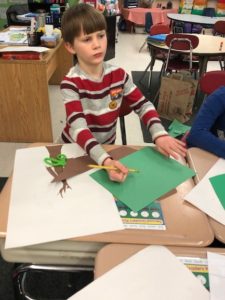 As a progressive school, our teachers seek out areas of integration within our curriculum. With the holiday of Tu B’shvat (the Jewish New Year for trees) approaching, second grade teachers worked collaboratively, weaving the theme into many subject areas. Students are reading poetry about trees and learning about the important role trees play in our environment using the scientific guiding question, “how can we work together to solve problems?” This question also happens to be a focus of second grade’s Social/Emotional curriculum which is reinforced through the literacy and science explorations.
As a progressive school, our teachers seek out areas of integration within our curriculum. With the holiday of Tu B’shvat (the Jewish New Year for trees) approaching, second grade teachers worked collaboratively, weaving the theme into many subject areas. Students are reading poetry about trees and learning about the important role trees play in our environment using the scientific guiding question, “how can we work together to solve problems?” This question also happens to be a focus of second grade’s Social/Emotional curriculum which is reinforced through the literacy and science explorations.
Spreading Tu B’shvat spirit to the rest of the school, the class will perform a Readers Theater production next week based on the story, Save the Lofty Trees by Leslie Mills. Readers Theater performances help students build fluency, confidence and stamina in reading – important second grade skills. Rhonda Mills, second grade’s Judaics Studies teacher, translated parts of the script so the students will perform in both Hebrew and English. They will also include Hebrew and Tu B’shvat songs accompanied by our resident musician, Chris Southiere. Introducing another subject area into the unit, second graders have been busy in TikkunXDesign building props for their production.